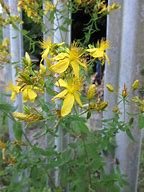 Image 1 of 2
Image 1 of 2

 Image 2 of 2
Image 2 of 2



St. John's Wort
St. John's wort is a champion at providing food and shelter to wildlife—especially pollinators—as well as adding blossoms, colorful foliage, and great texture to entry gardens, foundation plantings, perennial beds, and mixed shrub borders. This North American native all-star shrub is easy to grow and a cinch to incorporate into almost any landscape. You're sure to delight in its sunny yellow flowers in summer and low-maintenance habit year-round.
St. John's refers to the fact that the flowers were traditionally harvested on the Catholic Saint's Day honoring the nativity of St. John the Baptist, June 24. After harvesting the flowers, the believer would hang them over a painting or statue of St. John in the home. This practice was thought to protect the believer from evil spirits.
Medically St. John’s Wort can be used in salves and tinctures to help heal wounds, reduce inflammation. I use St. John's wort in my Eczema Skin Salve to help with the inflammation of irritated skin. The leaves can be dried into a powder for making capsules or teas to help with mild depression.
Plants are sold in a 4" pot.
St. John's wort is a champion at providing food and shelter to wildlife—especially pollinators—as well as adding blossoms, colorful foliage, and great texture to entry gardens, foundation plantings, perennial beds, and mixed shrub borders. This North American native all-star shrub is easy to grow and a cinch to incorporate into almost any landscape. You're sure to delight in its sunny yellow flowers in summer and low-maintenance habit year-round.
St. John's refers to the fact that the flowers were traditionally harvested on the Catholic Saint's Day honoring the nativity of St. John the Baptist, June 24. After harvesting the flowers, the believer would hang them over a painting or statue of St. John in the home. This practice was thought to protect the believer from evil spirits.
Medically St. John’s Wort can be used in salves and tinctures to help heal wounds, reduce inflammation. I use St. John's wort in my Eczema Skin Salve to help with the inflammation of irritated skin. The leaves can be dried into a powder for making capsules or teas to help with mild depression.
Plants are sold in a 4" pot.
St. John's wort is a champion at providing food and shelter to wildlife—especially pollinators—as well as adding blossoms, colorful foliage, and great texture to entry gardens, foundation plantings, perennial beds, and mixed shrub borders. This North American native all-star shrub is easy to grow and a cinch to incorporate into almost any landscape. You're sure to delight in its sunny yellow flowers in summer and low-maintenance habit year-round.
St. John's refers to the fact that the flowers were traditionally harvested on the Catholic Saint's Day honoring the nativity of St. John the Baptist, June 24. After harvesting the flowers, the believer would hang them over a painting or statue of St. John in the home. This practice was thought to protect the believer from evil spirits.
Medically St. John’s Wort can be used in salves and tinctures to help heal wounds, reduce inflammation. I use St. John's wort in my Eczema Skin Salve to help with the inflammation of irritated skin. The leaves can be dried into a powder for making capsules or teas to help with mild depression.
Plants are sold in a 4" pot.